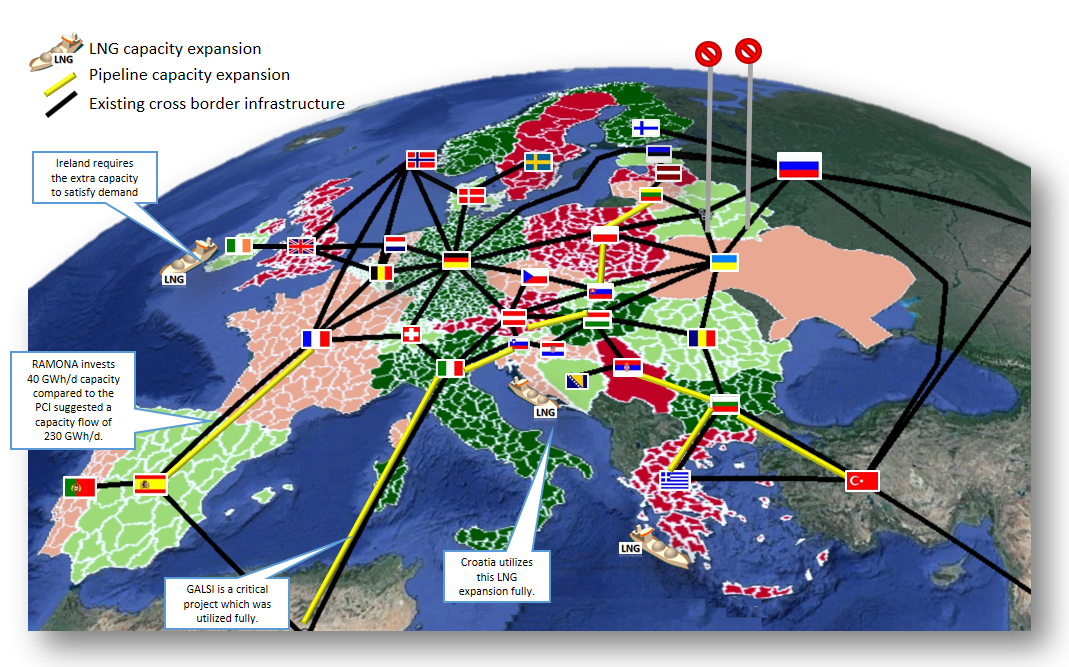GGM
Global Gas Model (GGM)
A multi-period equilibrium model for analysing the world natural gas market along the value chain from production wells to final consumers.
What is the GGM Model?
The Global Gas Model (GGM) is a multi-period equilibrium model for analyzing the world natural gas market along the value chain from production wells to final consumers. Market agents include producers, traders, transmission system (TSO) and storage operators (SSO). The TSO manages the pipeline network as well as the LNG liquefaction and regasification terminals.
The data set contains more than 90 countries thereby practically covering the entire global natural gas production and consumption. It also includes a detailed representation of cross-border pipeline, liquefaction, regasification and storage capacities. Some large countries are split in several production / consumption nodes. For each producing country the gas supplies to consumer markets are channelled through a country-specific trading arm, a trader. (E.g., the trader Russia coordinates the sales of all three production nodes within Russia, and the trader USA coordinates the sales of all ten production nodes in USA.) Traders can be assumed to exert market power. Any level between perfectly competitive (level 0) and Cournot (level 1) is possible, and the values can be different in different end-user markets and for time periods.

The Global Gas Model was developed together with professor Dr. Franziska Holz at DIW Berlin.
Illustrative results:
Model framework

GGM features |
|
|---|---|
|
GGM Inputs |
(Country and sub-country level)
|
|
GGM Outputs |
(Country and sub-country level)
|
Projects
GGM is Open Access
The GGM model is licensed under the MIT License (see below). Availability of model and data sets should improve understandability of results and analyses published elsewhere. We are not available for user support. However, if you find omissions or errors concerning the website, documentation, model code or data files we are grateful if you can send an email to ruud.egging@ntnu.no
Global Gas Model downloable version 2019
GGM Data documentation version 3 - April 2019
License
This work is licensed under the MIT License (MIT). Copyright (c) 2019 Ruud Egging (NTNU), Franziska Holz (DIW Berlin). Permission is hereby granted, free of charge, to any person obtaining a copy of this software and associated documentation files (the "Software"), to deal in the Software without restriction, including without limitation the rights to use, copy, modify, merge, publish, distribute, sublicense, and/or sell copies of the Software, and to permit persons to whom the Software is furnished to do so, subject to the following conditions:
The above copyright notice and this permission notice shall be included in all copies or substantial portions of the Software. The software is provided "as is", without warranty of any kind, express or implied, including but not limited to the warranties of merchantability, fitness for a particular purpose and noninfringement. in no event shall the authors or copyright holders be liable for any claim, damages or other liability, whether in an action of contract, tort or otherwise, arising from, out of or in connection with the software or the use or other dealings in the software.
References
- Ruud Egging and Franziska Holz (2019): Global Gas Model - Model and Data Documentation v3.0 (2019). DIW Data Documentation 100. DIW Berlin, Berlin (Germany). ISSN 1861-1532
- F. Holz, P.M. Richter, R. Egging, 2016. The Role of Natural Gas in a Low-Carbon Europe: Infrastructure and Supply Security, Energy Journal 37-S.I.3. (Preprint as DIW discussion paper 1273) http://dx.doi.org/10.5547/01956574.37.SI3.fhol
- R. Egging, F. Holz, 2016. Risks in global natural gas markets: investment, hedging and trade. Energy Policy Vol.94, p.468 . http://dx.doi.org/10.1016/j.enpol.2016.02.016 (Preprint as DIW discussion paper 1498)
- F. Holz, P. Richter, R. Egging, 2015. A Global Perspective on the Future of Natural Gas: Resources, Trade, and Climate Constraints. Review of Environmental Economics and Policy 2015 9(1): 85-106 http://dx.doi.org/10.1093/reep/reu016
- R. Egging, 2013. Benders decomposition for multi-stage stochastic mixed complementarity problems – Applied to a global natural gas market model. European Journal of Operational Research 226, pp. 341-353. http://dx.doi.org/10.1016/j.ejor.2012.11.024
If you find omissions or errors concerning the GGM website, documentation, GAMS code or data files we are grateful if you can send an email to ruud.egging@ntnu.no.
